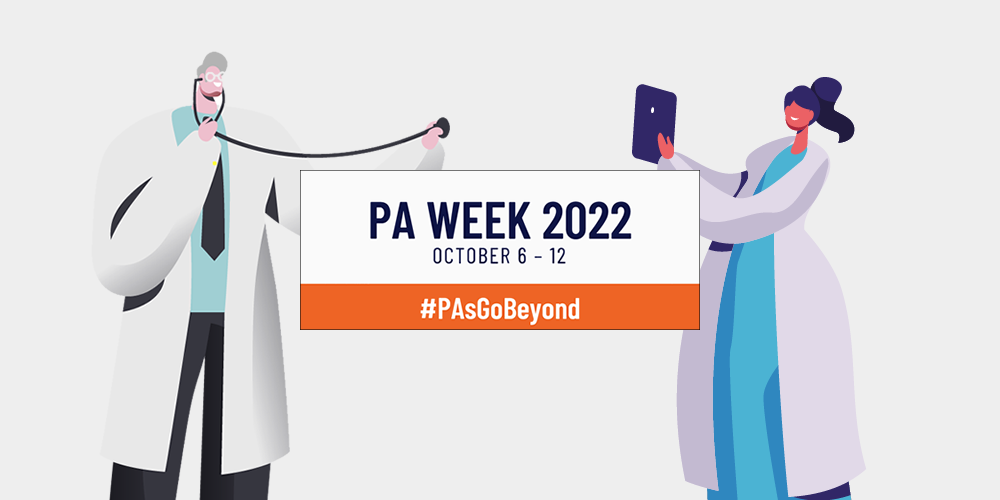Thanks to the American Academy of Physician Assistants (AAPA), network TV viewers couldn’t miss the 300+ white-coated physician assistants (PAs) and PA students packing the NBC and ABC studio plazas in New York City on Thursday morning, 10/6, to kick off #PAweek!
[adsanity_rotating align=”alignright” time=”7″ group_id=”1281″ max_width=”336″ random=”1″ /]#PAsGoBeyond is this year’s theme for the week of October 6-12, which recognizes the PA profession and its contributions to the nation’s health.
According to the AAPA, physician assistants are licensed clinicians who practice medicine in every specialty and setting, from hospitals and urgent care centers to outpatient offices and clinics. “PAs are dedicated to expanding access to care and transforming health and wellness through patient-centered, team-based medical practice,” the association notes.
U.S. World News & Report ranked PAs as the #2 in Best Healthcare Job for 2022, following the profession’s number-one ranking for 2021. (This year “nurse practitioner (NP)” took the list’s number-one spot.)
In contrast with nurse practitioners, who specialize in one area of medicine, PAs have a strong background in general medicine, according to the University of St. Augustine for Health Sciences.
Requirements
To obtain a license, a PA must graduate from one of the 293 PA programs in the United States. As one assistant professor of PA medicine noted on Twitter, “PAs get recertified every 10 years and must complete 100 hours of continuing medical education every two years to “stay on the cutting edge of medicine.”
Some Stats
“An estimated 93% of patients see PAs as trusted healthcare providers while 91% say they improve the quality of healthcare,” according to a #PAWeek post by Interim Physicians. “With over 514 million patient interactions each year and nearly 160,000 practitioners currently in service, physician assistants are one of the most popular provider types in 2022. That popularity will grow as projections indicate a 31% increase in the number of PAs by 2030. If these projections hold true, the number of PAs will eclipse 200,000 in a few short years.”
Compensation
A September 9 blog post by Gerry Carpenter for CompHealth indicates, “The 2022 report on physician associate (PA) compensation from the American Academy of PAs (AAPA) reveals that PA compensation varies considerably from state to state. As an example, Alabama pays on the low end with an average, unadjusted median base salary of $95,000 in 2021, while Alaska is on the high end paying $140,000…
“However, when a cost-of-living adjustment is applied to the data, it tells a different story. The highest and lowest paying states for PAs change positions—dramatically in some cases. ’When you look at how the states compare based on how expensive it is to live there, you see those numbers shift considerably,’ AAPA Senior Research Analyst Sean Kolhoff says. ‘Alaska’s adjusted median base salary drops to $114,462, while Alabama’s climbs to $109,497.’
The top five highest-paying states for PAs adjusted for cost of living are:
- Oklahoma ($132,457)
- Michigan ($128,872)
- Missouri ($128,365)
- Texas ($127,842)
- West Virginia ($125,952)
When adjusted for cost of living, buying power was lowest for PAs practicing in Hawaii and East Coast states: Rhode Island ($95,896), Massachusetts ($93,318), Maryland ($93,149), Hawaii ($92,784) and District of Columbia ($78,280).
History
NationalToday.com offers the following “Timeline Trivia” about the development of the physician assistant profession.
- The first class of physician assistants graduated from Duke University’s Medical Center in 1967.
- The American Association of Physician Assistants (now known as the American Academy of Physician Assistants) was incorporated in North Carolina in 1968.
- The National Board of Medical Examiners administered the first PA certification exam in 1973.
- Duke University awarded the first master’s degree for physician assistant education in 1988.
- Mississippi became the last state to authorize PA practice, making it legal in all 50 US states.
Avoid Burnout Through Locum Tenens
To quote another Comp Health article – this one written by Sharon Benedict and posted November 8, 2019: “PAs often describe their work as a calling and love working in medicine. Still, with high stress and long hours, the possibility of burnout is reality. That’s why many PAs are turning to locum tenens as a full-time career alternative that allows them to take control of their own schedule, establish a better work/life balance, and enjoy a regular change of scenery.”
To view comments from several PAs who spoke with Benedict about why they enjoy the locum tenens work style, click here.
For a succinct overview of the pros and cons of working as a locum tenens PA, go to an “Inside PA Training” blog post by Paul Kubin, PA-C, a career coach who helps those interested in becoming a physician assistant find their path. Having graduated as a PA in 2009, Kubin started coaching others in 2012 and added Lisa K. Walker, MPAS, PA-C, as a second coach on his team in 2019.
If you’re interested in working as a PA on a locum tenens basis and have questions about how it works through an agency, you might check out a recent blog post from AB Staffing Solutions here and get a bit more into the details through Aya Locums here.
Read a brief profile here of a PA who discovered locum tenens through Hayes Locums after her husband’s new teaching job took her to a new location.
All of this is to say it’s quite possible to “go beyond” traditional PA practice in the same hospital or medical office every day through locum tenens. #PAsGoBeyond










